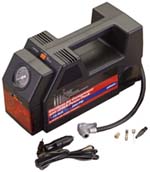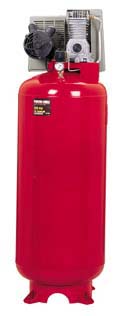Air compressors can be used for more than pumping up tires. In fact, these versatile tools can power nail guns, spray guns, wrenches and many other tools. Lowe’s is happy to provide this information as a service to you.
When shopping for air compressors, you ‘ll come across two basic types:
Types Of Compressor

Compact
Compact Compressor
Piston-Type Compressor
Piston-Type Compressor
* Piston-Type Compressors have tanks that store compressed air. The motor shuts off when the pressure in the tank reaches a specified level. As air is depleted from the tank, the pressure inside drops, and the motor restarts to build the pressure back up. The pressure settings are adjustable according to the operator’s requirements. There are two kinds of piston compressors:
* Single-Stage Compressors have one piston that compresses and delivers air to the storage tank. The single-stage system is normally found on light-duty compressors with a maximum rating below 150 pounds of pressure per square inch (psi). Single-stage compressors are adequate for most home users.
* Two Stage Compressors have two pistons that compress and deliver air to the storage tank. The first piston compresses the air and pushes it through a check valve to the second piston. The second piston further compresses the air and delivers it to the storage tank. The two-stage system is usually found on commercial heavy-duty compressors with maximum ratings above 150 psi. Two-stage compressors are good choices for continuous use or shop environments.
* Compact Air Compressors are the smallest and lightest compressors available. These compressors don’t have storage tanks, so they must run continuously to supply air. Compact compressors power caulk guns, glue guns, small spray guns, and can inflate sports equipment and tires.
 Other Considerations
Other Considerations
Horsepower Ratings are a measure of the horsepower (HP) the compressor motor produces. Compressor motors generally range from 1.5 HP to 6.5 HP. More powerful units are available for industrial applications. Usually higher horsepower motors yield greater psi and are capable of carrying a heavier workload.
Compressor Storage Tanks are rated in gallons. Larger tanks store more compressed air at higher pressures. The amount of air a compressor delivers is measured in cubic feet per minute (CFM). Note that the CFM a compressor delivers changes at varying psi. Most air tools have specific requirements for volume and pressure. These requirements must be met for the tool to function properly. When choosing a compressor, consider the tools you want it to operate. Select the tool that requires the highest CFM at the highest psi, and add 50% to the required CFM for a margin of safety. For example if a tool requires 3 CFM at 90 psi, select a compressor that delivers at least 4.5 CFM at 90 psi. Use this formula to ensure that the tool receives enough air to function properly.
Maintenance:
* Oil-Free Compressors have sealed bearings and require less maintenance than oil-lubricated compressors. Oil-free compressors have plenty of power for most noncommercial uses.
* Oil-Lubricated Compressors require the user to change the oil regularly. (Consult the owner’s manual for specific intervals). Most industrial compressors are oil-lubricated.
Power Supply:
* Electric-Powered Compressors are the most common and are easy to use in any area with a ready electrical supply.
* Gas-Powered Air Compressors are a good choice for areas where electricity is limited or unavailable. Don’t use gas-powered compressors in confined or unventilated areas.
When shopping for air compressors, you ‘ll come across two basic types:
Types Of Compressor

Compact
Compact Compressor
Piston-Type Compressor
Piston-Type Compressor
* Piston-Type Compressors have tanks that store compressed air. The motor shuts off when the pressure in the tank reaches a specified level. As air is depleted from the tank, the pressure inside drops, and the motor restarts to build the pressure back up. The pressure settings are adjustable according to the operator’s requirements. There are two kinds of piston compressors:
* Single-Stage Compressors have one piston that compresses and delivers air to the storage tank. The single-stage system is normally found on light-duty compressors with a maximum rating below 150 pounds of pressure per square inch (psi). Single-stage compressors are adequate for most home users.
* Two Stage Compressors have two pistons that compress and deliver air to the storage tank. The first piston compresses the air and pushes it through a check valve to the second piston. The second piston further compresses the air and delivers it to the storage tank. The two-stage system is usually found on commercial heavy-duty compressors with maximum ratings above 150 psi. Two-stage compressors are good choices for continuous use or shop environments.
* Compact Air Compressors are the smallest and lightest compressors available. These compressors don’t have storage tanks, so they must run continuously to supply air. Compact compressors power caulk guns, glue guns, small spray guns, and can inflate sports equipment and tires.

Horsepower Ratings are a measure of the horsepower (HP) the compressor motor produces. Compressor motors generally range from 1.5 HP to 6.5 HP. More powerful units are available for industrial applications. Usually higher horsepower motors yield greater psi and are capable of carrying a heavier workload.
Compressor Storage Tanks are rated in gallons. Larger tanks store more compressed air at higher pressures. The amount of air a compressor delivers is measured in cubic feet per minute (CFM). Note that the CFM a compressor delivers changes at varying psi. Most air tools have specific requirements for volume and pressure. These requirements must be met for the tool to function properly. When choosing a compressor, consider the tools you want it to operate. Select the tool that requires the highest CFM at the highest psi, and add 50% to the required CFM for a margin of safety. For example if a tool requires 3 CFM at 90 psi, select a compressor that delivers at least 4.5 CFM at 90 psi. Use this formula to ensure that the tool receives enough air to function properly.
Maintenance:
* Oil-Free Compressors have sealed bearings and require less maintenance than oil-lubricated compressors. Oil-free compressors have plenty of power for most noncommercial uses.
* Oil-Lubricated Compressors require the user to change the oil regularly. (Consult the owner’s manual for specific intervals). Most industrial compressors are oil-lubricated.
Power Supply:
* Electric-Powered Compressors are the most common and are easy to use in any area with a ready electrical supply.
* Gas-Powered Air Compressors are a good choice for areas where electricity is limited or unavailable. Don’t use gas-powered compressors in confined or unventilated areas.
